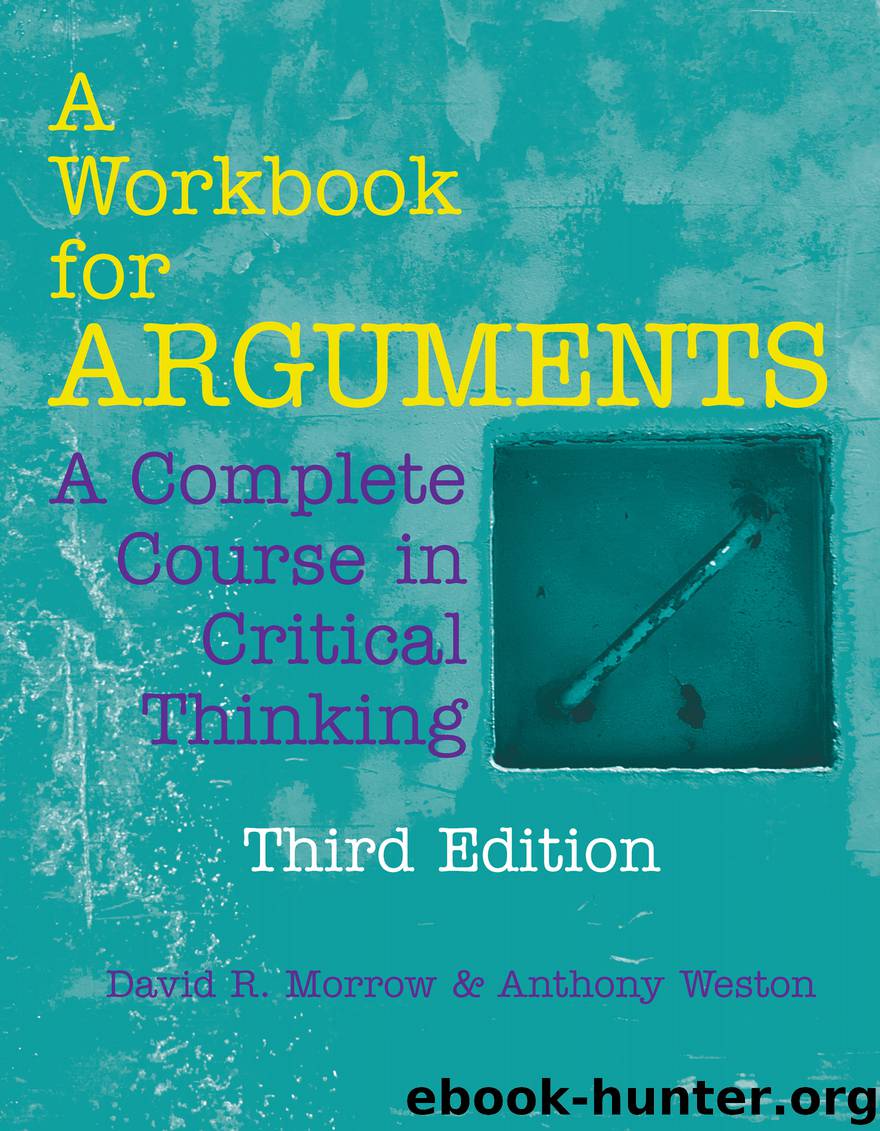A Workbook for Arguments by Morrow David R.; Weston Anthony;

Author:Morrow, David R.; Weston, Anthony;
Language: eng
Format: epub
Publisher: Hackett Publishing Company, Incorporated
Published: 2019-03-12T16:00:00+00:00
{279} Sample
What’s there to talk about? There are twelve people in this room, and eleven of them think the defendant is guilty. It’s plain as day, and nobody but you even had to think twice about it. Come on. Admit it! He’s guilty!
Adapted from: 12 Angry Men, directed by Sidney Lumet (Los Angeles: United Artist, 1957)
This argument appears to commit the ad populum fallacy by appealing to the “crowd’s” beliefs to justify the conclusion. Given that the context for this argument is a jury’s deliberation, we might reinterpret the argument along these lines: “All twelve jurors heard and saw all of the same evidence in the courtroom. Eleven of us found that evidence extremely compelling. You don’t know any more than we do about the case, so if you disagree, either you’ve made some kind of mistake or we have. And it seems more likely to me that one of us has made a mistake than that eleven of us have. So I think it’s reasonable to believe that you’ve made some kind of mistake.” The additional premises make it clear why the speaker takes the agreement of the other eleven jurors to be a good reason to believe that the twelfth juror is wrong.
This response highlights the alleged fallacy and then offers a more charitable interpretation of the argument, according to which it does not commit a fallacy. Note that the reinterpreted argument is presented in a much less antagonistic way, which helps promote discussion rather than frustration—an issue we discuss in Chapter X. More importantly, the response uses specific details of the argument in its explanation, rather than relying on vague generalities about how to reinterpret or revise a specific kind of fallacy. This is important because not all instances of a particular fallacy are amenable to the same kind of reinterpretation. As in this case, reinterpreting an argument can involve stating important assumptions that went unstated in the original version of the argument. In this example, that means pointing out that all of the jurors have seen and heard the same evidence about the case. (For those who have seen 12 Angry Men, spelling the argument out this way also explains one way in which the argument goes wrong. The twelfth juror does have some additional evidence: because he owns a switchblade just like the defendant’s, he knows that the prosecution was wrong in claiming the knife was unusual. And as it turns out, the twelfth juror eventually convinces the other eleven that he’s right after all. The defendant is not guilty!)
This way of thinking of the argument relates to a topic of discussion among philosophers who study epistemology, or the theory of knowledge: How, if at all, should we change our beliefs when we discover that other thoughtful people who have access to all of the same information disagree with us on a particular topic? So far, at least, philosophers can’t agree on the answer to that question.
Download
This site does not store any files on its server. We only index and link to content provided by other sites. Please contact the content providers to delete copyright contents if any and email us, we'll remove relevant links or contents immediately.
Cecilia; Or, Memoirs of an Heiress — Volume 1 by Fanny Burney(32001)
Cecilia; Or, Memoirs of an Heiress — Volume 3 by Fanny Burney(31425)
Cecilia; Or, Memoirs of an Heiress — Volume 2 by Fanny Burney(31370)
The Lost Art of Listening by Michael P. Nichols(7100)
We Need to Talk by Celeste Headlee(5379)
Asking the Right Questions: A Guide to Critical Thinking by M. Neil Browne & Stuart M. Keeley(5319)
On Writing A Memoir of the Craft by Stephen King(4635)
Dialogue by Robert McKee(4127)
Pre-Suasion: A Revolutionary Way to Influence and Persuade by Robert Cialdini(3942)
I Have Something to Say: Mastering the Art of Public Speaking in an Age of Disconnection by John Bowe(3748)
Elements of Style 2017 by Richard De A'Morelli(3216)
The Book of Human Emotions by Tiffany Watt Smith(3109)
Fluent Forever: How to Learn Any Language Fast and Never Forget It by Gabriel Wyner(2890)
Name Book, The: Over 10,000 Names--Their Meanings, Origins, and Spiritual Significance by Astoria Dorothy(2818)
Good Humor, Bad Taste: A Sociology of the Joke by Kuipers Giselinde(2806)
Why I Write by George Orwell(2743)
The Grammaring Guide to English Grammar with Exercises by Péter Simon(2626)
The Art Of Deception by Kevin Mitnick(2606)
Don't Sleep, There Are Snakes by Daniel L. Everett(2484)
